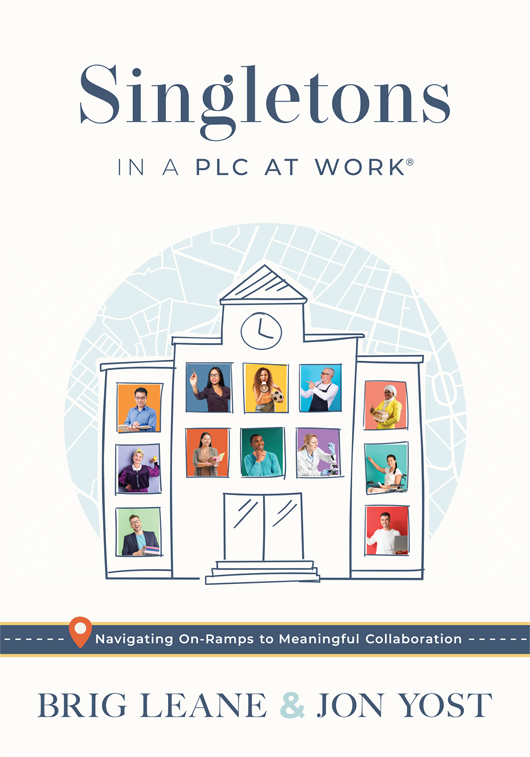Free Reproducibles
Singletons in a PLC at Work®
Navigating On-Ramps to Meaningful Collaboration
Collaboration among teachers is key for school improvement and student success. Most teachers will collaborate in grade-level or course-alike teams in a PLC, but what about singletons—those teachers who do not have grade-level or course-alike peers? In this resource, singleton teachers will find creative entry points to form meaningful collaborative teams.
Benefits
- Understand what meaningful collaboration is and how singletons can utilize the PLC process.
- Build the groundwork for meaningful collaboration using strategies for your specific situation.
- Implement meaningful collaboration as a singleton across separate schools or within the same school.
- Align disparate singletons under the same unifying PLC process.
TABLE OF CONTENTS
Introduction: PLCs, Collaborative Teams, and Singletons
Chapter 1: Meaningful Collaboration
Chapter 2: Singleton On-Ramps for Collaboration
Chapter 3: Preparation for Meaningful Collaboration
Chapter 4: Course-Alike On-Ramp: The Virtual Team
Chapter 5: Common-Content On-Ramp
Chapter 6: Critical-Friend On-Ramp
Chapter 7: Putting It All Together
Afterword: Final Thoughts
REPRODUCIBLES
Chapter 3
- Figure 3.1: Unpacking Template
- Figure 3.2: Identifying Essential Learning for Singletons—Preparation for Meaningful Collaboration
Chapter 4
- Figure 4.1: Course-Alike Team Commitments Form
- Figure 4.2: Course-Alike Team Process for Determining Essential Learning
- Figure 4.3: Course-Alike Team Process for Creating SMART Goals
- Figure 4.4: Action Plan for Intervention and Extension
- Figure 4.5: Final Data and Reflection on Changes to Instruction for Course-Alike Teams
Chapter 5
- Figure 5.1: Common-Content Template for PLC Critical Question One
- Figure 5.4: Common-Content Template for PLC Critical Question Two
- Figure 5.5: Common-Content Template for PLC Critical Questions Three and Four
Chapter 6
- Figure 6.1: Critical-Friend Template for PLC Critical Question One
- Figure 6.2: Critical-Friend Template for PLC Critical Question Two
- Figure 6.3: Critical-Friend Template for PLC Critical Questions Three and Four
Chapter 7
- Figure 7.1: PLC Product Tracker for School Leadership Teams
- Figure 7.2: Collaborative Team Guide for a Unit of Study
- Figure 7.3: Teacher Planning Checklist
- Figure 7.4: Leader Planning Checklist
SUGGESTED RESOURCES
Books
- Bailey, K., & Jakicic, C. (2017). Simplifying common assessment: A guide for Professional Learning Communities at Work. Bloomington, IN: Solution Tree Press.
- Brown, T., & Ferriter, W. M. (2021). You can learn! Building student ownership, motivation, and efficacy with the PLC at Work process. Bloomington, IN: Solution Tree Press.
- Buffum, A., Mattos, M., & Malone, J. (2018). Taking action: A handbook for RTI at Work. Bloomington, IN: Solution Tree Press.
- Dimich, N. (2015). Design in five: Essential phases to create engaging assessment practice. Bloomington, IN: Solution Tree Press.
- DuFour, R., DuFour, R., Eaker, R., Many, T. W., & Mattos, M. (2016). Learning by doing: A handbook for Professional Learning Communities at Work (3rd ed.). Bloomington, IN: Solution Tree Press.
- DuFour, R., DuFour, R., Eaker, R., Mattos, M., & Muhammad, A. (2021). Revisiting Professional Learning Communities at Work: Proven insights for sustained, substantive school improvement (2nd ed.). Bloomington, IN: Solution Tree Press.
- DuFour, R., & Eaker, R. (1998). Professional Learning Communities at Work: Best practices for enhancing student achievement. Bloomington, IN: Solution Tree Press.
- DuFour, R., & Marzano, R. J. (2011). Leaders of learning: How district, school, and classroom leaders improve student achievement. Bloomington, IN: Solution Tree Press.
- Eaker, R. (2020). A summing up: Teaching and learning in effective schools and PLCs at Work. Bloomington, IN: Solution Tree Press.
- Eaker, R., & Keating, J. (2012). Every school, every team, every classroom: District leadership for growing Professional Learning Communities at Work. Bloomington, IN: Solution Tree Press.
- Eaker, R., & Marzano, R. J. (Eds.). (2020). Professional Learning Communities at Work and High Reliability Schools: Cultures of continuous learning. Bloomington, IN: Solution Tree Press.
- Erkens, C., Schimmer, T., & Dimich, N. (2017). Essential assessment: Six tenets for bringing hope, efficacy, and achievement to the classroom. Bloomington, IN: Solution Tree Press.
- Hansen, A. (2015). How to develop PLCs for singletons and small schools. Bloomington, IN: Solution Tree Press.
- Kramer, S. V., & Schuhl, S. (2017). School improvement for all: A how-to guide for doing the right work. Bloomington, IN: Solution Tree Press.
- Marzano, R. J. (2017). The new art and science of teaching. Bloomington, IN: Marzano Resources.
- Mattos, M., DuFour, R., DuFour, R., Eaker, R., & Many, T. W. (2016). Concise answers to frequently asked questions about Professional Learning Communities at Work. Bloomington, IN: Solution Tree Press.
- Muhammad, A. (2018). Transforming school culture: How to overcome staff division (2nd ed.). Bloomington, IN: Solution Tree Press.
- Muhammad, A., & Cruz, L. F. (2019). Time for change: Four essential skills for transformational school and district leaders. Bloomington, IN: Solution Tree Press.
- Spiller, J., & Power, K. (2019). Leading with intention: Eight areas for reflection and planning in your PLC at Work. Bloomington, IN: Solution Tree Press.
- Wiliam, D. (2011). Embedded formative assessment. Bloomington, IN: Solution Tree Press.

